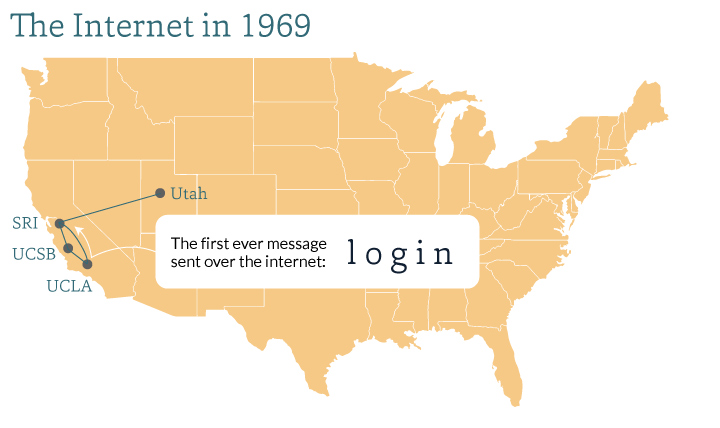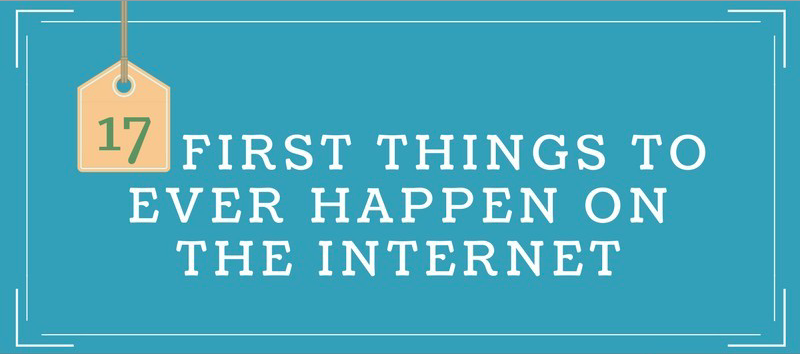Technology
A Look Back at Internet Firsts
In October 1969, UCLA student Charley Kline was attempting to send the word “login” over to the Stanford Research Institute using the internet’s precursor: ARPANET.
At first, the system crashed, only managing to send the letters “i” and “o”. But an hour or so later, the full message was successfully sent and history was made:

Today, the internet permeates every facet of modern life. Billions of people around the world communicate through messaging apps, email, and social media platforms. By 2020, an estimated 20.8 billion “things” will be connected to the internet (including 13 billion household items like TVs, smoke detectors, and appliances).
It all starts somewhere
Though YouTube, Facebook, and email are ubiquitous now, they all started out with a single post, profile, or message, and that first action is not always what you’d expect.
As today’s infographic from Academized demonstrates, “firsts” on the internet are typically unpolished, unique snapshots of the people involved in creating the platform. From elephants at the zoo to live-streaming a coffee pot, we hope you enjoy this trip down memory lane.

Links to Notable Internet Firsts
Everything posted to the web now lives in perpetuity.
Here are some notable internet firsts that can still be viewed, replicated, or experienced:
The First Search Engine
The first search engine was created to connect the McGill University’s School of Computer Science to the Internet. The engine, called Archie, was up-and-running in 1990, a full eight years before Google was created. The University of Warsaw still hosts a functioning version of Archie for historical purposes.
The First Amazon Order
Today, Amazon processes billions of orders per year, but the very first order was placed in July 1995. The grandiosely named book, Fluid Concepts and Creative Analogies: Computer Models Of The Fundamental Mechanisms Of Thought, was ordered by computer scientist John Wainwright, who was beta-testing Amazon.com.
The First YouTube Video
The very first YouTube video was uploaded by YouTube’s co-founder, Jawad Karim. The 19-second video is no Gangnam Style. Jawad, who is standing in front of an elephant enclosure, deadpans, “Uh. The cool thing about these guys is that, is that they have really, really, really long, um, trunks, and that’s, that’s cool.” Cool, indeed.
The First Tweet
just setting up my twttr
— jack (@jack) March 21, 2006
Internet firsts are rarely flashy, as this tweet from Twitter co-founder, Jack Dorsey, demonstrates. That said, as startups grow from rag-tag teams of determined founders into global behemoths, it’s nice to look back at those authentic, spontaneous first pieces of content.
Technology
Visualizing AI Patents by Country
See which countries have been granted the most AI patents each year, from 2012 to 2022.

Visualizing AI Patents by Country
This was originally posted on our Voronoi app. Download the app for free on iOS or Android and discover incredible data-driven charts from a variety of trusted sources.
This infographic shows the number of AI-related patents granted each year from 2010 to 2022 (latest data available). These figures come from the Center for Security and Emerging Technology (CSET), accessed via Stanford University’s 2024 AI Index Report.
From this data, we can see that China first overtook the U.S. in 2013. Since then, the country has seen enormous growth in the number of AI patents granted each year.
| Year | China | EU and UK | U.S. | RoW | Global Total |
|---|---|---|---|---|---|
| 2010 | 307 | 137 | 984 | 571 | 1,999 |
| 2011 | 516 | 129 | 980 | 581 | 2,206 |
| 2012 | 926 | 112 | 950 | 660 | 2,648 |
| 2013 | 1,035 | 91 | 970 | 627 | 2,723 |
| 2014 | 1,278 | 97 | 1,078 | 667 | 3,120 |
| 2015 | 1,721 | 110 | 1,135 | 539 | 3,505 |
| 2016 | 1,621 | 128 | 1,298 | 714 | 3,761 |
| 2017 | 2,428 | 144 | 1,489 | 1,075 | 5,136 |
| 2018 | 4,741 | 155 | 1,674 | 1,574 | 8,144 |
| 2019 | 9,530 | 322 | 3,211 | 2,720 | 15,783 |
| 2020 | 13,071 | 406 | 5,441 | 4,455 | 23,373 |
| 2021 | 21,907 | 623 | 8,219 | 7,519 | 38,268 |
| 2022 | 35,315 | 1,173 | 12,077 | 13,699 | 62,264 |
In 2022, China was granted more patents than every other country combined.
While this suggests that the country is very active in researching the field of artificial intelligence, it doesn’t necessarily mean that China is the farthest in terms of capability.
Key Facts About AI Patents
According to CSET, AI patents relate to mathematical relationships and algorithms, which are considered abstract ideas under patent law. They can also have different meaning, depending on where they are filed.
In the U.S., AI patenting is concentrated amongst large companies including IBM, Microsoft, and Google. On the other hand, AI patenting in China is more distributed across government organizations, universities, and tech firms (e.g. Tencent).
In terms of focus area, China’s patents are typically related to computer vision, a field of AI that enables computers and systems to interpret visual data and inputs. Meanwhile America’s efforts are more evenly distributed across research fields.
Learn More About AI From Visual Capitalist
If you want to see more data visualizations on artificial intelligence, check out this graphic that shows which job departments will be impacted by AI the most.
-

 Green1 week ago
Green1 week agoRanking the Top 15 Countries by Carbon Tax Revenue
-

 Technology2 weeks ago
Technology2 weeks agoThe Stock Performance of U.S. Chipmakers So Far in 2024
-

 Markets2 weeks ago
Markets2 weeks agoCharted: Big Four Market Share by S&P 500 Audits
-

 Real Estate2 weeks ago
Real Estate2 weeks agoRanked: The Most Valuable Housing Markets in America
-

 Money2 weeks ago
Money2 weeks agoWhich States Have the Highest Minimum Wage in America?
-

 AI2 weeks ago
AI2 weeks agoRanked: Semiconductor Companies by Industry Revenue Share
-

 Travel2 weeks ago
Travel2 weeks agoRanked: The World’s Top Flight Routes, by Revenue
-

 Countries2 weeks ago
Countries2 weeks agoPopulation Projections: The World’s 6 Largest Countries in 2075















